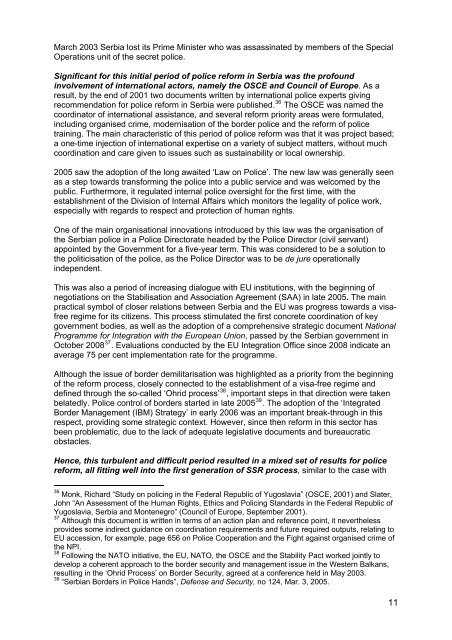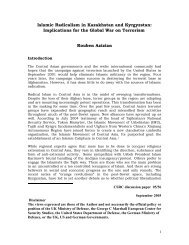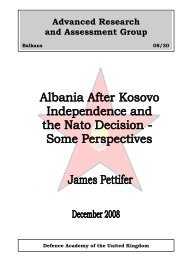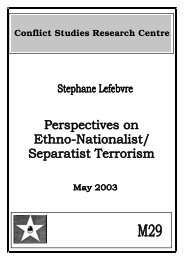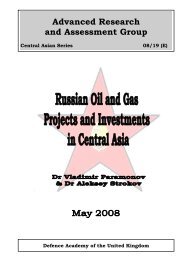Security Sector Reform and Donor Assistance in Serbia - Defence ...
Security Sector Reform and Donor Assistance in Serbia - Defence ...
Security Sector Reform and Donor Assistance in Serbia - Defence ...
Create successful ePaper yourself
Turn your PDF publications into a flip-book with our unique Google optimized e-Paper software.
March 2003 <strong>Serbia</strong> lost its Prime M<strong>in</strong>ister who was assass<strong>in</strong>ated by members of the SpecialOperations unit of the secret police.Significant for this <strong>in</strong>itial period of police reform <strong>in</strong> <strong>Serbia</strong> was the profound<strong>in</strong>volvement of <strong>in</strong>ternational actors, namely the OSCE <strong>and</strong> Council of Europe. As aresult, by the end of 2001 two documents written by <strong>in</strong>ternational police experts giv<strong>in</strong>grecommendation for police reform <strong>in</strong> <strong>Serbia</strong> were published. 36 The OSCE was named thecoord<strong>in</strong>ator of <strong>in</strong>ternational assistance, <strong>and</strong> several reform priority areas were formulated,<strong>in</strong>clud<strong>in</strong>g organised crime, modernisation of the border police <strong>and</strong> the reform of policetra<strong>in</strong><strong>in</strong>g. The ma<strong>in</strong> characteristic of this period of police reform was that it was project based;a one-time <strong>in</strong>jection of <strong>in</strong>ternational expertise on a variety of subject matters, without muchcoord<strong>in</strong>ation <strong>and</strong> care given to issues such as susta<strong>in</strong>ability or local ownership.2005 saw the adoption of the long awaited ‘Law on Police’. The new law was generally seenas a step towards transform<strong>in</strong>g the police <strong>in</strong>to a public service <strong>and</strong> was welcomed by thepublic. Furthermore, it regulated <strong>in</strong>ternal police oversight for the first time, with theestablishment of the Division of Internal Affairs which monitors the legality of police work,especially with regards to respect <strong>and</strong> protection of human rights.One of the ma<strong>in</strong> organisational <strong>in</strong>novations <strong>in</strong>troduced by this law was the organisation ofthe <strong>Serbia</strong>n police <strong>in</strong> a Police Directorate headed by the Police Director (civil servant)appo<strong>in</strong>ted by the Government for a five-year term. This was considered to be a solution tothe politicisation of the police, as the Police Director was to be de jure operationally<strong>in</strong>dependent.This was also a period of <strong>in</strong>creas<strong>in</strong>g dialogue with EU <strong>in</strong>stitutions, with the beg<strong>in</strong>n<strong>in</strong>g ofnegotiations on the Stabilisation <strong>and</strong> Association Agreement (SAA) <strong>in</strong> late 2005. The ma<strong>in</strong>practical symbol of closer relations between <strong>Serbia</strong> <strong>and</strong> the EU was progress towards a visafreeregime for its citizens. This process stimulated the first concrete coord<strong>in</strong>ation of keygovernment bodies, as well as the adoption of a comprehensive strategic document NationalProgramme for Integration with the European Union, passed by the <strong>Serbia</strong>n government <strong>in</strong>October 2008 37 . Evaluations conducted by the EU Integration Office s<strong>in</strong>ce 2008 <strong>in</strong>dicate anaverage 75 per cent implementation rate for the programme.Although the issue of border demilitarisation was highlighted as a priority from the beg<strong>in</strong>n<strong>in</strong>gof the reform process, closely connected to the establishment of a visa-free regime <strong>and</strong>def<strong>in</strong>ed through the so-called ‘Ohrid process’ 38 , important steps <strong>in</strong> that direction were takenbelatedly. Police control of borders started <strong>in</strong> late 2005 39 . The adoption of the ‘IntegratedBorder Management (IBM) Strategy’ <strong>in</strong> early 2006 was an important break-through <strong>in</strong> thisrespect, provid<strong>in</strong>g some strategic context. However, s<strong>in</strong>ce then reform <strong>in</strong> this sector hasbeen problematic, due to the lack of adequate legislative documents <strong>and</strong> bureaucraticobstacles.Hence, this turbulent <strong>and</strong> difficult period resulted <strong>in</strong> a mixed set of results for policereform, all fitt<strong>in</strong>g well <strong>in</strong>to the first generation of SSR process, similar to the case with36 Monk, Richard “Study on polic<strong>in</strong>g <strong>in</strong> the Federal Republic of Yugoslavia” (OSCE, 2001) <strong>and</strong> Slater,John “An Assessment of the Human Rights, Ethics <strong>and</strong> Polic<strong>in</strong>g St<strong>and</strong>ards <strong>in</strong> the Federal Republic ofYugoslavia, <strong>Serbia</strong> <strong>and</strong> Montenegro” (Council of Europe, September 2001).37 Although this document is written <strong>in</strong> terms of an action plan <strong>and</strong> reference po<strong>in</strong>t, it neverthelessprovides some <strong>in</strong>direct guidance on coord<strong>in</strong>ation requirements <strong>and</strong> future required outputs, relat<strong>in</strong>g toEU accession, for example, page 656 on Police Cooperation <strong>and</strong> the Fight aga<strong>in</strong>st organised crime ofthe NPI.38 Follow<strong>in</strong>g the NATO <strong>in</strong>itiative, the EU, NATO, the OSCE <strong>and</strong> the Stability Pact worked jo<strong>in</strong>tly todevelop a coherent approach to the border security <strong>and</strong> management issue <strong>in</strong> the Western Balkans,result<strong>in</strong>g <strong>in</strong> the ‘Ohrid Process’ on Border <strong>Security</strong>, agreed at a conference held <strong>in</strong> May 2003.39 “<strong>Serbia</strong>n Borders <strong>in</strong> Police H<strong>and</strong>s”, Defense <strong>and</strong> <strong>Security</strong>, no 124, Mar. 3, 2005.11


